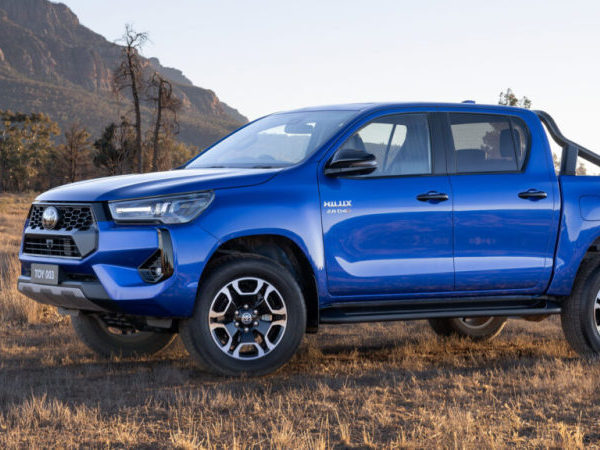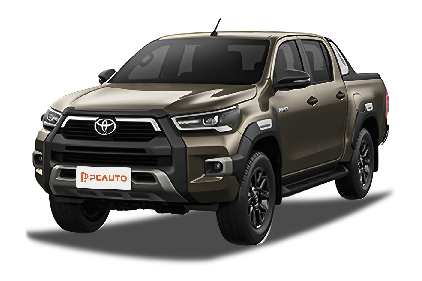Q
How fast is Hilux?
The speed performance of different Hilux models varies. Generally, the Hilux can reach a top speed of 180 km/h, with single-cab and chassis versions equipped with a six-speed manual or automatic transmission, capable of accelerating from 0 to 100 km/h in 12 seconds. For instance, the Toyota Hilux 2.8GD-6 DC 4×4 GR-Sport III achieves a 0-100 km/h acceleration time of 9.81 seconds and has a maximum speed of 175 km/h.
The actual speed of the vehicle can also be influenced by various factors, such as driving conditions and vehicle load. For example, in complex road scenarios or when fully loaded, the acceleration time may increase, and the top speed could be limited.
Special Disclaimer: This content is published by users and does not represent the views or position of PCauto.
Related Q&A
Q
Is a 2018 Hilux reliable?
The 2018 Toyota Hilux has built a solid reputation in Malaysia for its reliability and durability. Under the hood, you'll find either a 2.4-liter or 2.8-liter turbocharged diesel engine—proven powertrains that deliver consistent performance, easily handling Malaysia's diverse road conditions whether you're navigating city streets or tackling rough rural tracks. The Hilux's tough chassis and practically tuned suspension can handle heavy loads, making it a great fit for both work and family use. Toyota's extensive after-sales network across Malaysia means maintenance is a breeze with readily available parts, really enhancing the long-term ownership experience. On top of that, the Hilux holds its value well in the used car market, a clear sign that buyers trust its quality. If you're in the market for a tough pickup with reasonable running costs, the 2018 Hilux is definitely worth a look. Of course, when buying used, it's always smart to check the service records and actual condition to make sure it performs as expected.
Q
What kind of engine is in the 2018 Toyota Hilux SR5?
The 2018 Toyota Hilux SR5 is powered by the 2GD-FTV 2.4-liter turbocharged diesel engine. This four-cylinder diesel unit features common rail direct injection and a variable geometry turbocharger (VGT), pushing out 150 horsepower (110 kilowatts) and 400 Newton-meters of torque. Paired with a 6-speed automatic or manual transmission, it strikes a solid balance between performance and fuel efficiency, making it a great fit for Malaysia's diverse driving conditions – think city commutes and light off-roading. Part of Toyota's GD engine family, this powerplant is known for its reliability and low maintenance costs, while also meeting the strict emissions standards of its time. What really stands out is the diesel's strong low-end torque, which makes the Hilux shine when hauling loads or climbing hills. Toyota's D-4D technology also helps optimize combustion efficiency and keep carbon buildup in check. For Malaysian drivers who often hit the highway or need serious load-carrying capability, this powertrain is a practical choice. Plus, Toyota's well-established after-sales service network locally adds to the overall convenience of ownership.
Q
What is the fuel consumption of the 2018 Toyota Hilux?
The fuel efficiency of the 2018 Toyota Hilux varies depending on engine configuration and driving conditions. Models equipped with the 2.4-liter turbo diesel engine (2GD-FTV) have a combined fuel consumption of approximately 7.5 to 8.0 liters per 100 kilometers, while the 3.0-liter turbo diesel version (1KD-FTV) is slightly higher, around 8.0 to 8.5 liters per 100 kilometers. Actual fuel consumption may fluctuate based on load, road conditions, and driving habits. For Malaysian users, the Hilux's diesel engine design is well-suited to local needs of mountainous roads and long-distance driving, with its low-rev high-torque characteristics maintaining fuel efficiency when climbing hills or carrying cargo. To further optimize fuel consumption, it is recommended to perform regular maintenance (such as cleaning the air filter and maintaining proper tire pressure) and adopt a smooth acceleration driving style, avoiding sudden braking and rapid starts. As a popular model in the pickup truck market, the Hilux's durability and fuel economy have always been among the reasons favored by Malaysian consumers. Additionally, Toyota's after-sales network across the country provides convenient maintenance support for owners.
Q
What is the fuel economy of the 2018 Hilux?
The fuel economy of the 2018 Toyota Hilux in the Malaysian market varies depending on specific configurations and driving conditions. According to official figures, the 2.4L diesel variant delivers a combined fuel consumption of approximately 7.5-8.0 liters per 100 kilometers, while the 2.8L diesel model sits around 8.0-8.5 liters per 100 kilometers. Actual fuel usage may fluctuate based on load, road conditions, and driving habits. As one of Malaysia's most popular pickup trucks, the Hilux offers a balanced fuel economy within its segment, striking a good compromise between power and practicality. Notably, the diesel engine's low-end torque characteristics make it particularly suitable for users who frequently carry heavy loads or drive long distances, and Toyota's D-4D common rail technology also helps enhance combustion efficiency. It's advisable for owners to regularly maintain the engine and replace air filters to keep fuel consumption optimal, and try to maintain a smooth driving style. For those seeking better fuel economy, consider subsequent facelift models with more advanced powertrains, but the overall reliability of the 2018 Hilux has been widely proven in Malaysia's diverse terrain.
Q
Is the 2018 Hilux good for families?
The 2018 Toyota Hilux, as a pickup truck, excels in hauling and off-road capabilities, but there are some factors to weigh for daily family use. It boasts a tough body structure and reliable powertrain, with 2.4L or 2.8L diesel engines that handle long drives and rough terrain well. However, as a family vehicle, its rear-seat comfort can't match traditional SUVs or MPVs—those seats are pretty upright, which might get tiring on longer trips. Also, the back seat space is on the tight side; if you've got a bigger family or need to fit child safety seats, it could feel cramped. On the flip side, its high ground clearance and strong cargo capacity make it great for families into outdoor stuff, like camping or hauling lots of gear. If family comfort is your top priority, the brand's Innova or Fortuner might be better picks—they're more tailored for family needs. All in all, the 2018 Hilux is a solid choice if you need something that handles both work and light family use, but for purely family-focused driving, you might want to go with a more comfort-oriented model instead.
Q
What is a 2018 Hilux?
The 2018 Hilux is Toyota's eighth-generation Hilux pickup truck, a hit in Malaysia thanks to its toughness, off-road chops, and practicality. Under the hood, you'll find either a 2.4L or 2.8L turbo diesel engine, delivering solid power and decent fuel economy—perfect for everything from city cruising to backcountry adventures. Its generous ground clearance and part-time 4WD system make it a beast in Malaysia's rainy, muddy conditions. Inside, the focus is on usability, with a multifunction steering wheel and touchscreen infotainment system blending comfort and tech. Safety-wise, it comes with ABS, EBD, and multiple airbags. Malaysians love using the 2018 Hilux for commercial hauling, family trips, or even kitting it out as an off-roader, making it one of the best-selling pickups locally. Toyota offers various trims to suit different needs, and its reputation for reliability and strong resale value makes it a smart bet for long-term ownership.
Q
Does a 2018 Hilux have a timing belt or chain?
The 2018 Toyota Hilux comes with a timing chain instead of a timing belt, a design that offers better durability and lower maintenance costs. Unlike timing belts, which need regular replacement, timing chains generally just require periodic checks on lubrication – a real plus for Malaysian owners who tackle all sorts of road conditions. Chains hold up better under heavy loads and long hours of use, especially in tropical climates where their metal construction handles heat and humidity more reliably. Sure, timing chains might be a bit noisier at first, but they last way longer and eliminate the risk of catastrophic engine damage if a belt snaps. For a tough, reliable pickup like the Hilux, a timing chain makes total sense. Just stick to the manufacturer’s recommended maintenance schedule for checks, and your engine should keep running strong for the long haul.
Q
How long is the 2018 Hilux?
The 2018 Toyota Hilux measures 5330mm in length (including the rear bumper) with a 3085mm wheelbase, giving it solid practicality and road presence in the pickup segment. It’s a great fit for Malaysia’s diverse road conditions, handling both city drives and rural hauling with ease. As one of the most popular pickups in Southeast Asia, the Hilux has built a strong reputation for durability and off-road capability. The 2018 model comes with either a 2.4-liter or 2.8-liter turbo diesel engine, balancing power and fuel efficiency nicely. The cargo bed is around 1.5 meters long and nearly 1.6 meters wide, which covers most hauling needs, and the leaf spring rear suspension ensures it can handle heavy loads without breaking a sweat. For Malaysian buyers, there’s also a 4x4 version that tackles muddy monsoon roads or hilly terrain like a pro. On top of that, maintenance costs are reasonable, and the local after-sales service network is pretty well-established.
Q
Is the 2018 Hilux good for off-roading?
The 2018 Toyota Hilux delivers impressive off-road performance in Malaysia, making it a great fit for the country's diverse terrain. Under the hood, you've got reliable 2.4L or 2.8L turbo diesel engines that pump out plenty of low-end torque. Pair that with the part-time 4WD system and generous ground clearance, and it handles mud, sand, or steep slopes like a breeze. The rear differential lock ups the ante for getting out of sticky situations, while the tough ladder frame and suspension setup ensure it can take a beating on rough trails. Malaysian owners will also love the Hilux's modification potential – slap on a snorkel, beefy off-road tires, or underbody skid plates to dial up the off-road capability even more. Now, don't get me wrong, the Hilux is a beast off-road, but driver skill and route choice matter just as much. If you're into off-roading, I'd recommend signing up for proper training and keeping a close eye on key components like the drivetrain and brakes to stay safe out there. And with Malaysia's tropical weather, make sure you're extra diligent with maintaining the engine cooling system and electronics – that heat and humidity can really take a toll on your ride.
Q
What is a 2018 Toyota worth?
The price of a 2018 Toyota in Malaysia's used car market depends on factors like the specific model, mileage, condition, and specifications. Generally, popular models such as the Corolla Altis or Hilux command higher prices, ranging from around RM70,000 to RM120,000 for those in good condition. Mid-sized cars or SUVs like the Camry or Fortuner might fall between RM100,000 and RM150,000, though exact figures still hinge on market trends and the vehicle's service history. When buying a used Toyota, it's advisable to check the maintenance records, accident history, and the condition of the engine and gearbox, as these directly impact the car's actual value. Toyota is known in Malaysia for its durability and low maintenance costs, which translates to strong resale value in the used market. However, prices can vary slightly by region, so it's best to get more accurate quotes through local used car platforms or dealers. For hybrid models like the Prius, prices might be slightly lower due to battery lifespan concerns, but they still offer long-term fuel cost savings.
Popular Cars
Model Year
Car Compare
Car Photo
Latest Q&A
Q
How much does it cost to buy a 2024 Tesla Model 3?
The 2024 Tesla Model 3 starts at around RM 175,000, but the final price depends on your chosen configuration and add-ons. Opt for the Long Range or Performance version, and you’re looking at a higher tag.
As Tesla’s entry-level model, it packs cutting-edge EV tech, including 500+ km of range on a single charge and standard Autopilot for both daily commutes and road trips. Just keep in mind extra costs like insurance, registration, and potential home charger installation.
Tesla’s Supercharger network is expanding locally, with solid coverage in major cities, making charging hassle-free. Maintenance costs? Typically lower than gas cars—no oil changes, fewer moving parts—so long-term savings add up.
If you’re after more thrills, the Performance variant hits 0-100 km/h in roughly 3 seconds. Plus, government EV tax perks help soften the upfront cost.
Q
How reliable is the 2024 Model 3?
The 2024 Model 3 delivers solid reliability, thanks to Tesla’s continuous software updates and hardware refinements. Key areas like the battery management system and Autopilot have seen multiple optimizations, leading to a noticeable drop in failure rates.
This model features a stiffer body structure and an improved suspension setup, offering a smoother ride. Upgraded interior materials also help reduce cabin rattles—a common gripe with earlier builds.
EV maintenance costs remain low (no oil changes, etc.), though it’s wise to periodically check battery health and charging components for long-term performance. For shoppers eyeing EVs, charging infrastructure and home charging options matter—thankfully, public chargers are expanding fast, making daily use more convenient.
If you frequently road-trip, planning charging stops ahead helps. While the range easily handles daily drives, a little route prep goes a long way in maximizing the experience.
Q
What is the battery range of the Tesla Model 3 2025?
The battery range of Tesla Model 3 2025 is expected to be optimized based on existing models, and specific data needs to be released officially. However, referring to the EPA range of the 2024 rear wheel drive version, which is about 438 kilometers, and the high-performance version, which is about 513 kilometers, the 2025 model may further improve, especially in terms of battery technology or energy efficiency management. For electric vehicles, the range is greatly affected by driving habits, road conditions, and climate. Air conditioning may slightly reduce the range in hot weather, but the battery thermal management system can usually maintain stable performance. In terms of charging, Model 3 supports super fast charging, which can replenish about 250 kilometers of range in about 15 minutes, while home charging stations require 6-8 hours to fully charge. Daily commuting or long-distance travel are practical enough, it is recommended to follow Tesla's official website or local showroom for the latest information.
Q
Is the 2024 Model 3 worth the price?
The 2024 Model 3 strikes an impressive balance between price and performance. Its upgraded range, more refined interior, and enhanced autonomous driving features genuinely boost its competitiveness—especially for tech-savvy, eco-conscious buyers.
Tesla optimized the battery efficiency this time around, making it suitable for both daily commutes and longer trips, while the handling stays true to the brand’s signature responsiveness. If your budget allows and you’re open to EVs, this one’s worth considering—though a test drive is wise to see if it matches your driving style.
That said, local charging access matters. While public chargers are becoming more common, home installation costs should factor into your budget. Alternatives in this price range exist, so cross-shop specs and service policies (like warranty coverage or charging network support) to make a well-rounded decision.
Q
How many miles does a 2024 Tesla Model 3 get?
The 2024 Tesla Model 3 offers varying range figures depending on configuration. The rear-wheel-drive (RWD) version delivers an EPA-estimated 272 miles (approx. 438 km), while the all-wheel-drive Long Range model pushes that to around 341 miles (roughly 549 km). Real-world range may vary slightly based on driving style, road conditions, and climate.
As a pure EV, the Model 3 achieves this efficiency thanks to its advanced battery management system and lightweight design. It also supports fast charging—at a Tesla Supercharger, you can add up to 200 km of range in about 15 minutes. Whether for daily commutes or longer trips, that’s more than enough for most drivers, especially with charging infrastructure becoming more widespread.
If you need to maximize range, tweaking your driving mode or using the car’s built-in energy optimization features can help squeeze out even more miles.
View MoreRelated News

2026 Toyota HiLux receives five-star ANCAP safety rating in ANCAP
MichaelDec 12, 2025

Why are people more willing to choose Toyota Hilux instead of Isuzu D-Max?
JamesNov 3, 2025

There is news that the next-generation Toyota Hilux will be released in November, bringing a major redesign.
MichaelSep 28, 2025

2026 Toyota Hilux Interior Unveiled, and It’s Giving Prado Vibes
JohnAug 6, 2025

All-New 2025 Toyota Hilux Coming Soon: Here's What to Expect
JamesJun 24, 2025
View More


















Pros
Cons